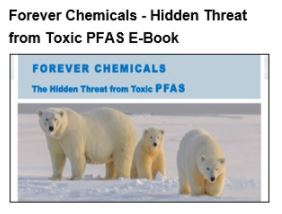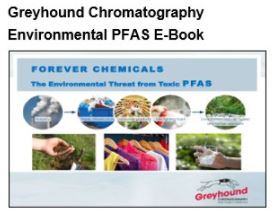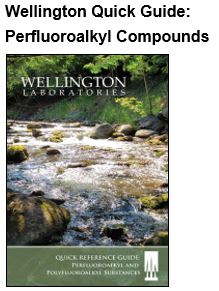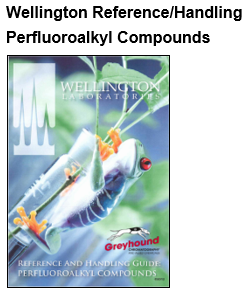Persistent Organic Pollutants (PoPs) Reported as Decreasing in the Arctic



Wellington Laboratories are at the forefront of development of Certified Reference Standards and Materials to assist scientists in the monitring and analysis of contaminents of environmental concern.
Wellington’s Reference Standards are used mainly in Environmental/analytical testing and toxicological research. Wellington offers an extensive inventory of individual certified reference standards and solution mixtures of native and mass-labelled halogenated organic compounds including polychlorinated dibenzo-p-dioxins, polychlorinated dibenzofurans, polychlorinated biphenyls, halogenated flame retardants and perfluoronated compounds. Wellington also offer a variety of calibration sets and support solutions designed to be used for common regulatory methods of modified in-house methods.
Wellington Laboratories are committed to the distribution of quality products as well as the maintenance of excellent customer service. In fact, in order to provide your customers with the best possible service, Wellington have three ISO certifications (ISO 9001:2008, ISO/IEC 17025:2005, and ISO Guide 34:2009) which cover all aspects of planning, production, testing, distribution, and post-distribution service. These certifications allow Wellington to monitor and maintain the highest level of quality and service and also allow their customers to satisfy the requirements of their own ISO certifications.
Wellington’s ISO/IEC 17025:2005 accreditation has been certified by the Canadian Association for Laboratory Accreditation Inc. (CALA) the scope is available for review on the CALA Directory of Accredited Laboratories (http://www.cala.ca).
Similarly, Wellington’s ISO Guide 34:2009 accreditation has been certified by ANSI-ASQ National Accreditation Board (ANAB), the certificate and scope are available on their website (http://anab.org/).
We are able to supply hard copies of any of the ISO certificates for yourself and your customers.
The full range of Wellington's products can be found at Greyhound's website

Read The Article Here
Levels of some persistent organic pollutants (POPs) regulated by the Stockholm Convention are decreasing in the Arctic, according to an international team of researchers who have been actively monitoring the northern regions of the globe.
POPs are a diverse group of long-lived chemicals that can travel long distances from their source of manufacture or use. Many POPs were used extensively in industry, consumer products or as pesticides in agriculture. Well-known POPs include chemicals such as DDT and PCBs (polychlorinated biphenyls), and some of the products they were used in included flame retardants and fabric coatings.
Because POPs were found to cause health problems for people and wildlife, they were largely banned or phased out of production in many countries. Many have been linked to reproductive, developmental, neurological and immunological problems in mammals. The accumulation of DDT, a well-known and heavily used POP, was also linked to eggshell-thinning in fish-eating birds, such as eagles and pelicans, in the late 20th century, and caused catastrophic population declines for those animals.
In 2001, 152 countries signed a United Nations treaty in Stockholm, Sweden intended to eliminate, restrict or minimize unintentional production of 12 of the most widely used POPs. Later amendments added more chemicals to the initial list. Today, more than 33 POP chemicals or groups are covered by what is commonly called the “Stockholm Convention,” which has been recognized by182 countries.
“This paper shows that following the treaty and earlier phase-outs have largely resulted in a decline of these contaminants in the Arctic,” says John Kucklick, a biologist from the National Institute of Standards and Technology (NIST) and the senior U.S. author on the paper, published August 23 in Science of the Total Environment. “When POP use was curtailed, the change was reflected by declining concentrations in the environment.”
“In general, the contaminants that are being regulated are decreasing,” says Frank Rigét from the Department of Bioscience, Aarhus University, Denmark, and lead author.
POPs are particularly problematic in the Arctic because the ecosystem there is especially fragile, and pollution can come from both local sources and from thousands of miles away due to air and water currents. POPs also bioaccumulate. This means that they build up faster in animals and humans than they can be excreted, and that exposure can increase up the food chain. Plankton exposed to POPs in water are eaten by schools of fish, which are in turn eaten by seals or whales, and with each jump up the food chain the amount of POPs increases. The same is true for terrestrial animals. A large mammal’s exposure, therefore, can be large and long-lasting.
Indigenous people living in northern coastal areas such as Alaska often consume more fish and other animals that come from higher on the food chain than the average American. Such communities, therefore, are potentially exposed to larger amounts of these pollutants.
For almost two decades beginning in 2000, Kucklick and Rigét worked in conjunction with scientists from Denmark, Sweden, Canada, Iceland and Norway to track POPs in the fat of several marine mammals and in the tissue of shellfish and seabirds. They also monitored air in the Arctic circle for pollution.
To gain a fuller picture of how the deposition of POPs might have changed over time, the study included specimens archived since the 1980s and ’90s in special storage facilities around the globe. The U.S. specimens were provided by the NIST Biorepository, located in Charleston, South Carolina. Samples archived in that facility are part of the Alaska Marine Mammal Tissue Archival Project (AMMTAP) or the Seabird Tissue Archival and Monitoring Project (STAMP). Both collections are conducted in collaboration with other federal agencies.
The study pooled more than 1,000 samples taken over the course of several decades from many different locations throughout the Arctic Circle. In general, the so-called legacy POPs—those that have been eliminated or restricted from production—were shown to be decreasing over the past two to three decades, although some had decreased more than others.
The biggest decreases were in a byproduct of the pesticide lindane, a-HCH, with a mean annual decline of 9 percent in Arctic wildlife.
The research team found PCBs had decreased as well. Most industrial countries banned PCBs in the 1970s and ’80s, and their production was reduced under the Stockholm Convention in 2004. Previously, the compounds had been widely used in electrical systems. In this study, it was found that their presence had decreased by almost 4 percent per year across the Arctic region since being pulled from the market.
Two of the legacy POPs listed under Stockholm, β-HCH and HCB, showed only small declines of less than 3 percent per year. β-HCH was part of a heavily-used pesticide mixture with the active ingredient lindane and HCB was used both in agriculture and industry.
A small number of the legacy POPs had increased in a few locations, although some of those were at sites suspected to be influenced by strong, still-existing local pollution sources.
Notably, the flame retardant hexabromocyclododecane (HBCDD) showed an annual increase of 7.6 percent. HBCDD was one of 16 additional POPs added to the Stockholm Convention as of 2017 and is recommended for elimination from use, with certain exemptions.
Most of the research conducted for this paper was a direct result of the 2001 treaty stipulations, which included a requirement that sponsors participate in ongoing, long-term biological monitoring. Although the U.S. participated in the research, it has not ratified the treaty. It is expected that work on the treaty will continue as new POPs are identified.
This recent research work highlights the usefulness of long-term data and international scientific collaboration, says Rigét. “You really need to gather more than 10 years of data before you can see the trend because in the short term there can be some small fluctuations,” he notes. “Looking at this data also showed us how to be more economical and avoid over-sampling in the future.”
This article has been republished from materials provided by the National Institute of Standards and Technology. Note: material may have been edited for length and content. For further information, please contact the cited source.
Reference
Frank Rigét, Anders Bignert, Birgit Braune, Maria Dam, Rune Dietz, Marlene Evans, Norman Green, Helga Gunnlaugsdóttir, Katrin S. Hoydal, John Kucklick, Robert Letcher, Derek Muir, Stacy Schuur, Christian Sonne, Gary Stern, Gregg Tomy, Katrin Vorkamp, Simon Wilson. Temporal trends of persistent organic pollutants in Arctic marine and freshwater biota. Science of The Total Environment, 2018; DOI: 10.1016/j.scitotenv.2018.08.268.
Perfluorinated Reference Standard M3PFBA from Wellington Laboratories

The presence of lower homologues of perfluorinated carboxylic acids in environmental samples may be the result of contamination from point sources or degradation of related perfluorinated compunds. Although it has been reported that perfluorobutanoic acid is not likely to bioaccumualte,
Wellington Laboratories Inc. (Wellington) is recognised world-wide as a reputable and trusted source of certified reference Standards of organic compounds of environmental concern.
The majority of Wellington’s products are used for trace analysis or toxicological research and thus their quality is vital. This quality, as well as the success and longevity of the company, is primarily because of the people of Wellington Inc. Wellington Laboratories has a well-qualified, dynamic mix of synthetic chemists, analytical chemists and administrative personnel who are committed to customer service and continual improvement. This is recognised in Wellington’s ISO registration and accreditations.
Wellington Reporter February 27 2012
Wellington Laboratories
For Over 35 years Wellington Laboratories Inc. has been internationally recognised as a trusted source of high quality reference standard solutions for use in environmental/analytical testing and toxicological research. Wellington Laboratories offers an extensive inventory of individual certified reference standards and solution mixtures of native and mass-labelled halogenated organic compounds including polychlorinated dibenzo-p-dioxins, polychlorinated dibenzofurans, polychlorinated biphenyls, halogenated flame retardants and perfluorinated compounds. Wellington Laboratories also offer a variety of calibration sets and support solutions designed to be used for common regulatory methods or modified in-house methods.
Wellington’s Reference Standards are used mainly in Environmental/analytical testing and toxicological research. Wellington offers an extensive inventory of individual certified reference standards and solution mixtures of native and mass-labelled halogenated organic compounds including polychlorinated dibenzo-p-dioxins, polychlorinated dibenzofurans, polychlorinated biphenyls, halogenated flame retardants and perfluoronated compounds. Wellington also offer a variety of calibration sets and support solutions designed to be used for common regulatory methods of modified in-house methods.
Wellington Laboratories are committed to the distribution of quality products as well as the maintenance of excellent customer service. In fact, in order to provide your customers with the best possible service, Wellington have three ISO certifications (ISO 9001:2008, ISO/IEC 17025:2005, and ISO Guide 34:2009) which cover all aspects of planning, production, testing, distribution, and post-distribution service. These certifications allow Wellington Laboratories to monitor and maintain the highest level of quality and service and also allow their customers to satisfy the requirements of their own ISO certifications.
Wellington’s ISO/IEC 17025:2005 accreditation has been certified by the Canadian Association for Laboratory Accreditation Inc. (CALA) the scope is available for review on the CALA Directory of Accredited Laboratories (http://www.cala.ca).
Similarly, Wellington’s ISO Guide 34:2009 accreditation has been certified by ANSI-ASQ National Accreditation Board (ANAB), the certificate and scope are available on their website (http://anab.org/).
We are able to supply hard copies of any of the ISO certificates for yourself and your customers.
Posters Presented by Wellington Laboratories 

Individual PCDDs and PCDFs : Native and Mass-Labelled
Wellington offers a wide variety of native and mass-labelled polychlorinated dioxin and furan congeners to meet your analytical needs.
Whenever possible, our compounds are synthesized using unambiguous, one-product synthetic routes and are provided to you at a purity of 98% or greater. In addition, the 2,3,7,8-substituted PCDDs and PCDFs are traceable to a number of interlaboratory studies dating back to 1991.
Investigating Levels of Halogenated Aromatic Compounds in a Highly Contaminated Municipal Waste Incinerator Fly Ash Sample
Scientists from Wellington Laboratories attend conferences and workshops on a regular basis. We believe that staying up-to-date with emerging environmental contaminants and global regulations allows us to offer the most relevant reference standards to our customers.
Attending conferences also allows us to share some of the research that is conducted at our facility in Guelph through poster and oral presentations. A few examples of posters presented by Wellington are provided below for your review.
Posters Presented by Wellington Laboratories 

Individual PCDDs and PCDFs : Native and Mass-Labelled
Wellington offers a wide variety of native and mass-labelled polychlorinated dioxin and furan congeners to meet your analytical needs.
Whenever possible, our compounds are synthesized using unambiguous, one-product synthetic routes and are provided to you at a purity of 98% or greater. In addition, the 2,3,7,8-substituted PCDDs and PCDFs are traceable to a number of interlaboratory studies dating back to 1991.
Investigating Levels of Halogenated Aromatic Compounds in a Highly Contaminated Municipal Waste Incinerator Fly Ash Sample
Scientists from Wellington Laboratories attend conferences and workshops on a regular basis. We believe that staying up-to-date with emerging environmental contaminants and global regulations allows us to offer the most relevant reference standards to our customers.
Attending conferences also allows us to share some of the research that is conducted at our facility in Guelph through poster and oral presentations. A few examples of posters presented by Wellington are provided below for your review.


For over 40 years Greyhound Chromatography has been supplying high quality Chromatography consumables to laboratories around the world. Greyhound’s extensive range covers all areas of Environmental, Petrochemical, Food, Forensics, Chemical and Pharmaceutical analysis. Backed by a highly experienced technical services team, Greyhound is the preferred source amongst today’s analysts.
Greyhound Chromatography is pleased to supply Wellington Laboratories Certified Reference Standards to Research and Analysis laboratories worldwide.
CONTACT US
Tel: +44 (0) 151 649 4000
Web: www.greyhoundchrom.com
Email: marketing@greyhoundchrom.com
FOLLOW US




YOU MAY ALSO BE INTERESTED IN OUR NEWSLETTER
SIGN UP HERE

CATALOGUE DOWNLOADS































